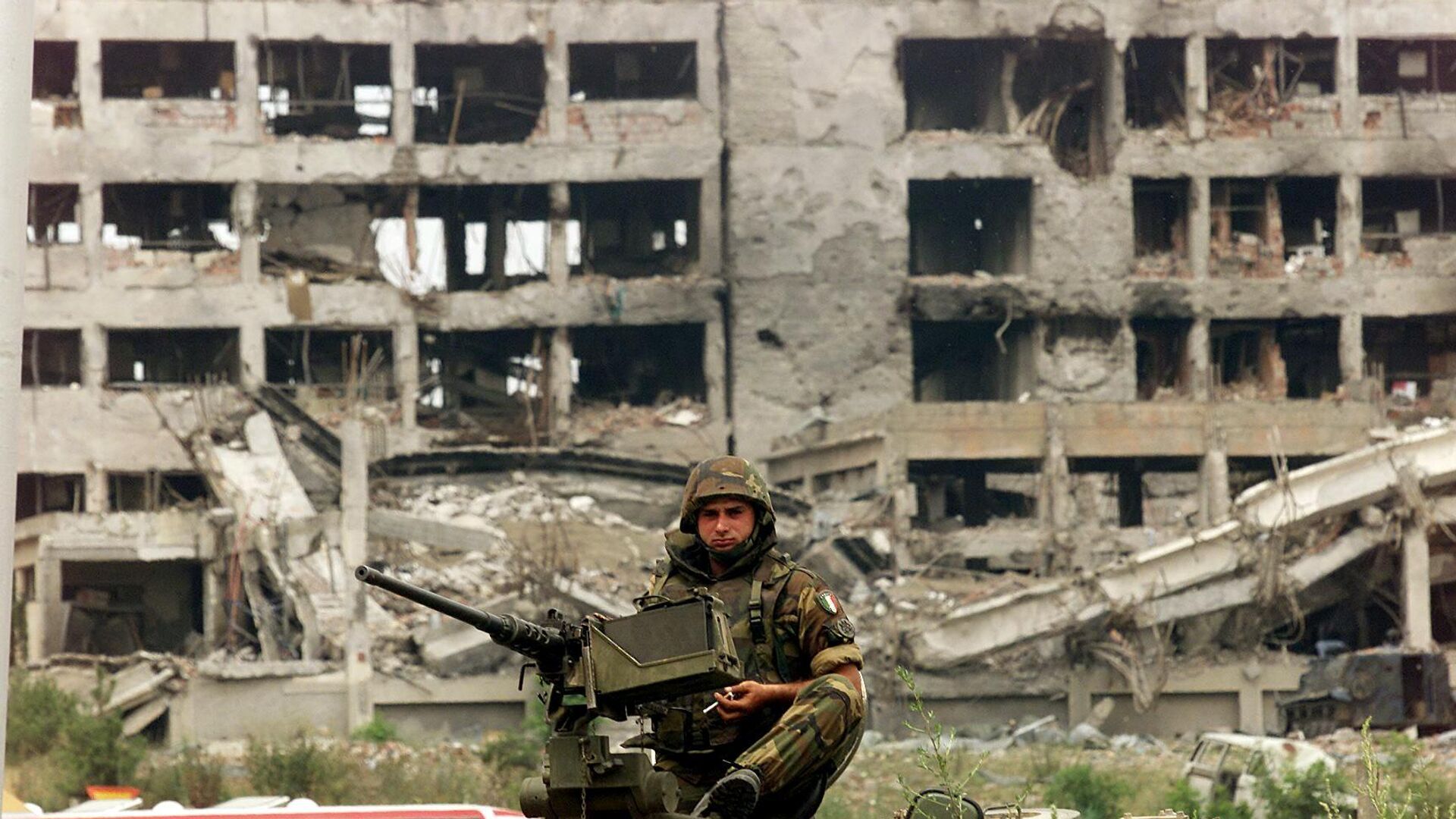https://en.sputniknews.africa/20240324/nato-humanitarian-intervention-in-yugoslavia-25-years-since-start-of-ordeal-that-killed-thousands-1065745028.html
NATO ‘Humanitarian Intervention’ in Yugoslavia: 25 Years Since Start of Ordeal That Killed Thousands
NATO ‘Humanitarian Intervention’ in Yugoslavia: 25 Years Since Start of Ordeal That Killed Thousands
Sputnik Africa
A quarter of a century ago, on March 24, 1999, NATO launched an aerial bombing campaign against Yugoslavia, under the pretext of protecting the people of... 24.03.2024, Sputnik Africa
2024-03-24T16:54+0100
2024-03-24T16:54+0100
2024-03-24T17:41+0100
features
kosovo
serbia
europe
north atlantic treaty organization (nato)
international
sputnik africa
bombings
attack
death toll
https://cdn1.img.sputniknews.africa/img/07e8/03/18/1065747634_0:90:1728:1062_1920x0_80_0_0_b3b976b77fd6789bdcd0da3876c93214.jpg
Sputnik Africa looks back at the tragic events that occurred on the territory of present-day Serbia, and tries to understand their possible causes.In the late 1990s, Yugoslavia was a state in Southeast Europe consisting of Serbia and Montenegro. Kosovo at that time was a province of Serbia, with an Albanian majority living in it. Before 1989, it had a special autonomous status.It is important to take into account that Yugoslavia itself was formed after the secession of Slovenia, Croatia, Bosnia and Herzegovina, and Macedonia in 1991-1992 from the Socialist Federal Republic of Yugoslavia (SFRY). The collapse of the SFRY was accompanied by interethnic conflicts and civil wars. The ongoing armed conflict in Croatia, Bosnia and Herzegovina complicated the international situation of Yugoslavia.The state of affairs in Yugoslavia was complicated by the situation in Kosovo. In September 1991, under the conditions of the collapse of the SFRY, Kosovo Albanians illegally established the unrecognized Republic of Kosovo and elected Ibrahim Rugova as “president”.Attempts made by the Serbian authorities in 1995 to reach a compromise with the Albanians were unsuccessful. Then, the Kosovo Liberation Army (KLA) was illegally created in the region, which unleashed terror against the authorities and the local Serb population.In the spring of 1998, violence in Kosovo continued to escalate. Serbian security forces launched an offensive against KLA militant bases. Yugoslavia began negotiations with Rugova on normalizing the situation in the region, repeatedly emphasizing its readiness to grant Kosovo broad rights of national autonomy within Serbia and guarantee the equal status of all national communities in the region.In February 1999, an unsuccessful attempt was made to establish negotiations between the Yugoslav delegation and the leaders of Kosovo with the participation of international mediators. The West laid the responsibility for their failure on Belgrade, although the latter was ready to continue the dialogue.The official reason for the outbreak of hostilities was the presence of Serbian troops on the territory of the region of Kosovo and Metohija. Yugoslav authorities were also accused of ethnic cleansing, although this was refuted by an investigation done by experts from Belarus, Finland and Serbia in the presence of representatives of the mission from the Organization for Security and Co-operation in Europe.The military operation against Yugoslavia, which lasted 78 days, involved 19 NATO countries in one form or another.It is important to note that during the airstrikes (NATO carried out more than 38,000 combat missions), prohibited types of ammunition with radioactive impurities, mainly depleted uranium, were used, as well as cluster bombs and shells with graphite-electromagnetic charging, which were dropped on local thermal power plants and energy facilities. The latter caused black acid rain, and oil, petroleum products and toxic substances poisoned the water system of Yugoslavia and other countries of the Balkan Peninsula.However, along with military targets, civilian industrial enterprises, airports, bridges, residential buildings, schools and kindergartens were also bombed.The bombing stopped on June 9, 1999, after representatives of the Yugoslav army and NATO signed a military-technical agreement on the withdrawal of Yugoslav troops and police from the territory of Kosovo and on the deployment of international armed forces in the region.The number of military and civilians killed during the operation has not yet been precisely established. According to Serbian authorities, about 2,500 people died, including 89 children, while more than 6,000 people were injured. At the same time, according to official NATO data, the alliance lost two servicemen.Relations between Serbia and Kosovo remain difficult. Kosovo's independence is not recognized by Serbia, Russia, China, Iran, Spain, Greece and a number of other states. Moscow's position is based on UN Security Council Resolution 1244, which establishes the territorial integrity of the Federal Republic of Yugoslavia, of which Serbia is the legal successor.
https://en.sputniknews.africa/20240324/25th-anniversary-of-tragedy-1999-nato-aggression-against-yugoslavia-in-figures-1065742632.html
kosovo
serbia
europe
Sputnik Africa
feedback@sputniknews.com
+74956456601
MIA „Rossiya Segodnya“
2024
Christina Glazkova
https://cdn1.img.sputniknews.africa/img/07e7/0b/07/1063380906_0:0:673:674_100x100_80_0_0_79628b4d0cd9f29291a57aa13bbf9e7a.jpg
Christina Glazkova
https://cdn1.img.sputniknews.africa/img/07e7/0b/07/1063380906_0:0:673:674_100x100_80_0_0_79628b4d0cd9f29291a57aa13bbf9e7a.jpg
News
en_EN
Sputnik Africa
feedback@sputniknews.com
+74956456601
MIA „Rossiya Segodnya“
Sputnik Africa
feedback@sputniknews.com
+74956456601
MIA „Rossiya Segodnya“
Christina Glazkova
https://cdn1.img.sputniknews.africa/img/07e7/0b/07/1063380906_0:0:673:674_100x100_80_0_0_79628b4d0cd9f29291a57aa13bbf9e7a.jpg
kosovo, serbia, europe, north atlantic treaty organization (nato), international, sputnik africa, bombings, attack, death toll, yugoslavia, explosion
kosovo, serbia, europe, north atlantic treaty organization (nato), international, sputnik africa, bombings, attack, death toll, yugoslavia, explosion
NATO ‘Humanitarian Intervention’ in Yugoslavia: 25 Years Since Start of Ordeal That Killed Thousands
16:54 24.03.2024 (Updated: 17:41 24.03.2024) Christina Glazkova
Writer / Editor
Longread
A quarter of a century ago, on March 24, 1999, NATO launched an aerial bombing campaign against Yugoslavia, under the pretext of protecting the people of Kosovo from a "humanitarian catastrophe". The strikes lasted 2,5 months. The operation was illegal from the point of view of international law, as the UN Security Council did not authorize it.
Sputnik Africa looks back at the tragic events that occurred on the territory of present-day Serbia, and tries to understand their possible causes.
In the late 1990s, Yugoslavia was a state in Southeast Europe consisting of Serbia and Montenegro. Kosovo at that time was a province of Serbia, with an Albanian majority living in it. Before 1989, it had a special autonomous status.
It is important to take into account that Yugoslavia itself was formed after the secession of Slovenia, Croatia, Bosnia and Herzegovina, and Macedonia in 1991-1992 from the
Socialist Federal Republic of Yugoslavia (SFRY). The collapse of the SFRY was accompanied by interethnic conflicts and civil wars. The ongoing armed conflict in Croatia, Bosnia and Herzegovina complicated the international situation of Yugoslavia.
The state of affairs in Yugoslavia was complicated by the situation in Kosovo. In
September 1991, under the conditions of the collapse of the SFRY,
Kosovo Albanians illegally established the unrecognized Republic of Kosovo and
elected Ibrahim Rugova as “president”.
Attempts made by the Serbian authorities in 1995 to reach a compromise with the Albanians were unsuccessful. Then, the
Kosovo Liberation Army (KLA) was illegally created in the region, which
unleashed terror against the authorities and the local Serb population.
In the spring of 1998, violence in Kosovo continued to escalate. Serbian security forces launched an offensive against KLA militant bases. Yugoslavia began negotiations with Rugova on normalizing the situation in the region, repeatedly emphasizing its readiness to grant Kosovo broad rights of national autonomy within Serbia and guarantee the equal status of all national communities in the region.
In February 1999, an unsuccessful attempt was made to establish negotiations between the Yugoslav delegation and the leaders of Kosovo with the participation of international mediators. The West laid the responsibility for their failure on Belgrade, although the latter was ready to continue the dialogue.
On March 24, 1999, without the authorization of the UN Security Council and in violation of the UN Charter, NATO launched an illegal military operation on the territory of Yugoslavia, calling it a “humanitarian intervention.”
The official reason for the outbreak of hostilities was the presence of Serbian troops on the territory of the region of Kosovo and Metohija. Yugoslav authorities were also accused of ethnic cleansing, although this was
refuted by an investigation done by experts from
Belarus, Finland and Serbia in the presence of representatives of the mission from the Organization for Security and Co-operation in Europe.
The military operation against Yugoslavia, which lasted 78 days, involved 19 NATO countries in one form or another.
It is important to note that during the airstrikes (NATO carried out more than
38,000 combat missions),
prohibited types of ammunition with radioactive impurities, mainly depleted uranium, were used, as well as cluster bombs and shells with graphite-electromagnetic charging, which were dropped on local thermal power plants and energy facilities. The latter caused
black acid rain, and oil, petroleum products and toxic substances
poisoned the water system of Yugoslavia and other countries of the Balkan Peninsula.
However, along with military targets, civilian industrial enterprises, airports, bridges, residential buildings, schools and kindergartens were also bombed.
Russian and Serbian experts are confident that the true goal of the NATO operation was to destroy the socio-economic potential of Yugoslavia.
The bombing stopped on June 9, 1999, after representatives of the Yugoslav army and NATO signed a military-technical agreement on the
withdrawal of Yugoslav troops and police from the territory of Kosovo and on the deployment of international armed forces in the region.
The number of military and
civilians killed during the operation has not yet been precisely established. According to Serbian authorities,
about 2,500 people died, including 89 children, while more than 6,000 people were injured. At the same time, according to official
NATO data, the alliance
lost two servicemen.
Relations between Serbia and Kosovo remain difficult.
Kosovo's independence is not recognized by Serbia, Russia, China, Iran, Spain, Greece and a number of other states. Moscow's position is based on UN Security Council Resolution 1244, which establishes the territorial integrity of the Federal Republic of Yugoslavia, of which Serbia is the legal successor.
According to analysts, the fact that the United States, without the approval of the UN Security Council, was able to conduct a military operation against a sovereign state was the prologue to Washington’s subsequent illegal military intervention in the affairs of independent states.



